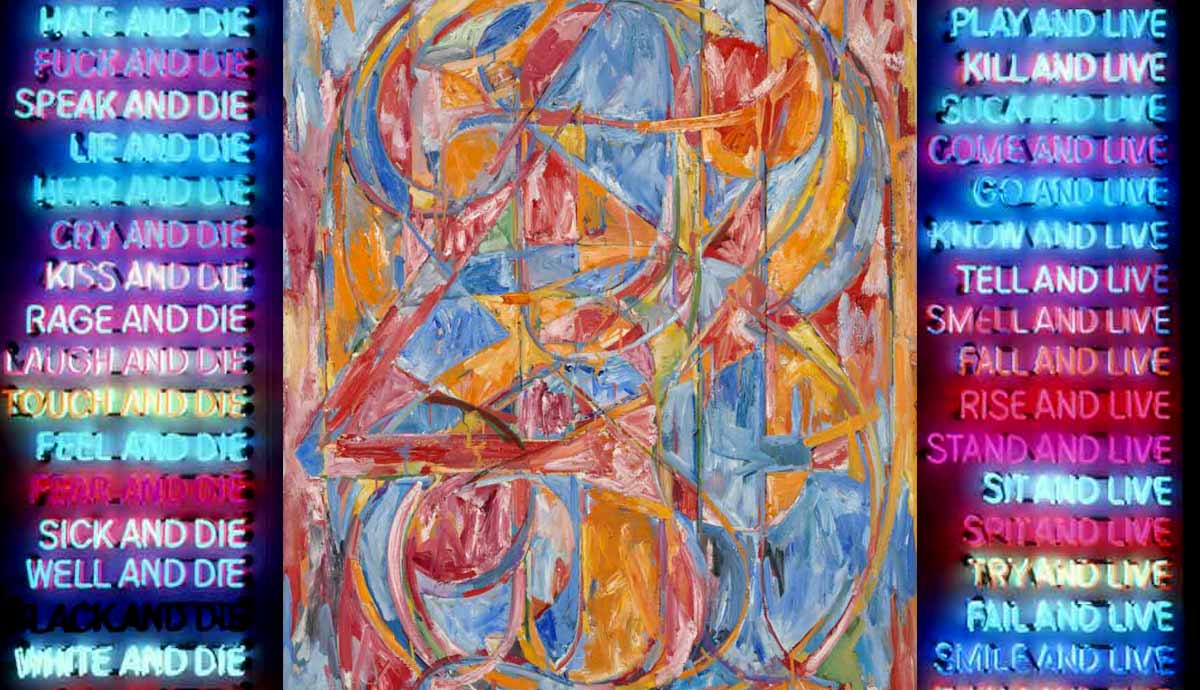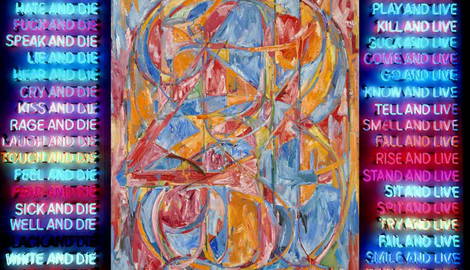
The things that confound us often become the subjects of our obsessions. This might explain why so many famous artists create works centered around language, text, and numbers. Dyslexia levels in the arts are among the highest in any industry, and many cases go undiagnosed. This fosters a culture of fascination with text. Let’s explore the work of five artists who have utilized language to their advantage, telling stories richer than images alone.
1. Bruce Nauman

Bruce Nauman was born in 1941 in Indiana, USA. The premise of Bruce Nauman’s One Hundred Live and Die is remarkably simple, yet the work has graced some of the world’s most prominent galleries. Nauman’s neon text stands as one of the most significant works of art that emerged in the 1980s. The artist had already experimented with neon before making this piece but it surely represents one of the clearest expressions of his artistic identity.
He made his first neon piece during the mid-1960s and he was always fascinated with the idea of using text to question the meaning of things. By stringing a short sentence—live and die—repeatedly, Nauman invited viewers into his own consciousness. Our involuntary reaction to text is to read it, and the pace of Nauman’s One Hundred Live and Die ensures that nearly everyone who encounters it does so with the same internal voice. This act transforms a static work into a piece of interactive performance art.
2. Ellen Gallagher

Ellen Gallagher is an American artist, born in 1965 in Rhode Island. While the text found in her artworks isn’t always original, Ellen proves that it does not even have to be for the artwork to have its impact on the viewers. Approaching its twentieth anniversary, DeLuxe is a piece of art dedicated to Black culture and the fight against racism. The piece is made up of 60 prints that refer to African American culture and the importance of hair in it.
Gallagher chose many texts to be featured in this work. These include inserts from magazine pages targeting Black women readers such as Our World, Ebony, Jet, and Sepia. Gallagher also used magazine pages dating back to the 1930s. The artist also emphasized the passage of time to her audience by incorporating the original magazine text.
The collaged images and magazine pages mostly refer to the significance of Afro hair for Black cultural identity. In 2004, when the work was made, finding information on Afro hair in fashion magazines beyond a select few was hard. Although it is still uncommon to find a lot of popular press on this topic today, it is not unheard of. The text, whether original or added by Gallagher, compels viewers to spend more time with the artwork. In this instance, the text acts as a tool that enhances public interaction. Despite the dated nature of the text and images the artist used, DeLuxe establishes a lasting connection with its readers.
3. Georges Perec

Georges Perec was a famous French filmmaker and novelist, born in 1936. He often created works inspired by wordplay. Perec’s Species of Spaces stands as a pivotal text for those delving into the works of the French Oulipo movement, of which he was a member. The Oulipo group was made up of writers, journalists, poets, and mathematicians, dedicated to rewriting the functions of language. The group has existed since the 1960s.
Perec’s book Species of Spaces engages with nearly every physical structure of text, incorporating marginal notes, graphic typesetting, and concrete poems in a series of essays and poems. His exploration revolves around the empty space on a page, acknowledging that for dyslexic brains, this void can be both a barrier to functional reading and a trigger for creativity. In Perec’s work, the blank space becomes as critical to the narrative as any letter or number.
Beyond his playful texts, Perec’s fascination with language extended to ambitious projects such as attempting to use every word in the dictionary before he died. It is also interesting to know that his most regular paycheck came from compiling newspaper crosswords. In his relentless pursuit to understand how text functioned, Georges Perec lived a dedicated and inspiring life as an artist and a creative writer.
4. Jasper Johns

Jasper Johns is a famous American artist best known for his Neo-Dadaist artworks. He was born in 1930 in Georgia, USA. Jasper’s career-defining motif revolves around numbers. Throughout his career, the artist consistently used numbers because of their universal comprehensibility. Numbers transcend language barriers while undeniably being a part of it. In Jasper Johns’ work, numbers often demonstrate patterns or repetition. Additionally, they play a role in managing the spatial composition of a canvas, both literally and sequentially.
In his series 0 Through 9, Johns overlays each number, creating an image that challenges viewers to engage with the paintings themselves rather than fixating on the subject. Admittedly, Johns’ theory has its flaws, but, in general, he utilized numbers devoid of specific meaning. The audience is therefore encouraged to focus on the technique the artist used and the composition of the painting rather than to seek the inherent meaning.

Jasper Johns’ enduring fascination with numbers persisted over many years, as he explored the same forms both with and without color. In later versions, the emphasis shifted towards the pattern. A 1967-69 etching, for instance, reveals lines and penmanship that evoke a more Gaelic influence than an expressive one. Across these various iterations, the same puzzle persisted, however.
One might question why an artist renowned for expressive mark-making continued to use such recognizable forms in his paintings. Fortunately, his flag paintings and consistent use of targets as generically recognizable shapes provide insight. Much like his number paintings, Johns aimed for the recognizable forms to fade into the background, allowing the viewer to focus on his craftsmanship.
5. Tom Phillips

When Tom Phillips (born Trevor Thomas Phillips) died in 2022, he left a legacy of book art that will inspire future generations. Philips was a British artist, born in London in 1937. His work is instantly recognizable and has been held in public collections since the 1950s. Many of his illustrative annotations share similar traits—they are untitled. Most are produced on the pages of old books by selectively blanking out text and then connecting portions of words or phrases that deliver new meanings.
A Humument: A Treated Victorian Novel was initially published in 1970 and finally completed by the artist in 2016 after undergoing numerous changes and tweaks. Rewriting an existing story inherently allowed for the potential evolution of the narrative, but only within the constraints of the original text and the layout of the work called Human Document by W. H. Mallock. To anyone attempting to decipher Tom Phillips’ re-edited story, a traditional narrative may not be apparent. Instead, what emerges is a captivating collage of text and images. Among artists who have integrated text into their work, this manipulation of language stands out as profoundly engaging.
Famous Artists’ Love of Alphanumerics

Some artists subtly integrate words into their works, but those who overtly use text tell a different story. While written language can be a barrier in many contexts, in art, it becomes a malleable tool. Artists can take control of the beauty of language, reinventing its structures and rules. Figures like Georges Perec and Tom Phillips exemplify this approach. Jasper Johns and Bruce Nauman are equally crucial for understanding how artists manipulate alphanumerics, albeit with more subtle methods.
The next time you visit a gallery, artworks centered around language might be the ones that compel you to stop and stare. Language proves to be a powerful tool in art, fostering a more rational relationship between the artist and the viewer. Perhaps a picture never truly speaks a thousand words—unless it incorporates them.







